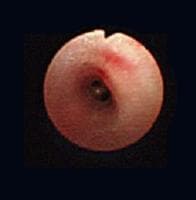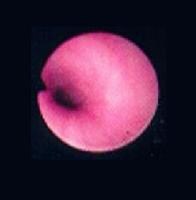Examples of normal airway color and architecture and an airway in a patient with chronic bronchitis are shown below.
 Normal airway color and architecture
Normal airway color and architecture(in a child with mild tracheomalacia).
 Airway of a child with chronic bronchitis shows erythema, loss of normal architecture, and swelling. Symptoms of acute bronchitis usually include productive cough and sometimes retrosternal pain during deep breathing or coughing. Generally, the clinical course of acute bronchitis is self-limited, with complete healing and full return to function typically seen within 10-14 days following symptom onset.
Airway of a child with chronic bronchitis shows erythema, loss of normal architecture, and swelling. Symptoms of acute bronchitis usually include productive cough and sometimes retrosternal pain during deep breathing or coughing. Generally, the clinical course of acute bronchitis is self-limited, with complete healing and full return to function typically seen within 10-14 days following symptom onset.Chronic bronchitis is recurring inflammation and degeneration of the bronchial tubes that may be associated with active infection. Patients with chronic bronchitis have more mucus than normal because of either increased production or decreased clearance. Coughing is the mechanism by which excess secretion is cleared.
Chronic bronchitis is often associated with asthma, cystic fibrosis, dyskinetic cilia syndrome, foreign body aspiration, or exposure to an airway irritant. Recurrent tracheobronchitis may occur with tracheostomies or immunodeficiency states.
Defining chronic bronchitis and its prevalence in childhood has been complicated by the significant clinical overlap with asthma and reactive airway disease states. In adults, chronic bronchitis is defined as daily production of sputum for at least 3 months in 2 consecutive years. Some have applied this definition to childhood chronic bronchitis. Others limit the definition to a productive cough that lasts more than 2 weeks despite medical therapy.
Chronic bronchitis has also been defined as a complex of symptoms that includes cough that lasts more than 1 month or recurrent productive cough that may be associated with wheezing or crackles on auscultation. Elements of these descriptors are present in the working definitions of asthma, as well.
Treatment of chronic bronchitis in pediatric patients includes rest, use of antipyretics, adequate hydration, and avoidance of smoke.
Analgesics and antipyretics target the symptoms of pediatric bronchitis. In chronic cases, bronchodilator therapy should be considered. Oral corticosteroids should be added if cough continues and the history and physical examination findings suggest a wheezy form of bronchitis.
No comments:
Post a Comment